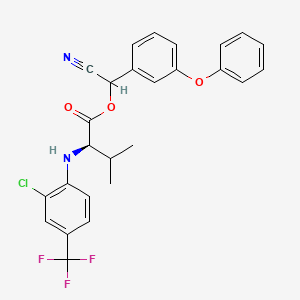D1108 | tau-fluvalinate
| Toxicity | Dose | Time | Species | Model | Method | Action | Positive criterion | Reference |
|---|---|---|---|---|---|---|---|---|
| MEMBRANE POTENTIAL | 37.16±15.12 | human | qHTS-HepG2 | MMP assay | decrease | IC50 | 163 | |
| MEMBRANE POTENTIAL | 31.62 | human | HepG2 | MMP assay | decrease | IC50 | 163 | |
| MEMBRANE POTENTIAL | rat | hepatocytes | MMP assay | Negative | IC50 | 163 | ||
| Pictogram | Signal | Statements | Precautionary Statement Codes |
|---|---|---|---|
  |
Warning |
H302: Harmful if swallowed [Warning Acute toxicity, oral] H315: Causes skin irritation [Warning Skin corrosion/irritation] H400: Very toxic to aquatic life [Warning Hazardous to the aquatic environment, acute hazard] H410: Very toxic to aquatic life with long lasting effects [Warning Hazardous to the aquatic environment, long-term hazard] |
P264, P270, P273, P280, P301+P312, P302+P352, P321, P330, P332+P313, P362, P391, and P501; (The corresponding statement to each P-code can be found at the GHS Classification page.) |
  |
Warning |
Aggregated GHS information provided by 247 companies from 3 notifications to the ECHA C&L Inventory. Each notification may be associated with multiple companies. H302 (99.6%): Harmful if swallowed [Warning Acute toxicity, oral] H315 (100%): Causes skin irritation [Warning Skin corrosion/irritation] H400 (100%): Very toxic to aquatic life [Warning Hazardous to the aquatic environment, acute hazard] H410 (100%): Very toxic to aquatic life with long lasting effects [Warning Hazardous to the aquatic environment, long-term hazard] Information may vary between notifications depending on impurities, additives, and other factors. The percentage value in parenthesis indicates the notified classification ratio from companies that provide hazard codes. Only hazard codes with percentage values above 10% are shown. |
P264, P270, P273, P280, P301+P312, P302+P352, P321, P330, P332+P313, P362, P391, and P501; (The corresponding statement to each P-code can be found at the GHS Classification page.) |
  |
Warning |
H302: Harmful if swallowed [Warning Acute toxicity, oral] H315: Causes skin irritation [Warning Skin corrosion/irritation] H410: Very toxic to aquatic life with long lasting effects [Warning Hazardous to the aquatic environment, long-term hazard] |
P264, P270, P273, P280, P301+P312, P302+P352, P321, P330, P332+P313, P362, P391, and P501; (The corresponding statement to each P-code can be found at the GHS Classification page.) |
  |
Danger |
H301: Toxic if swallowed [Danger Acute toxicity, oral] H330: Fatal if inhaled [Danger Acute toxicity, inhalation] H361: Suspected of damaging fertility or the unborn child [Warning Reproductive toxicity] H370: Causes damage to organs [Danger Specific target organ toxicity, single exposure] H373: Causes damage to organs through prolonged or repeated exposure [Warning Specific target organ toxicity, repeated exposure] |
P201, P202, P260, P264, P270, P271, P281, P284, P301+P310, P304+P340, P307+P311, P308+P313, P310, P314, P320, P321, P330, P403+P233, P405, and P501; (The corresponding statement to each P-code can be found at the GHS Classification page.) |
    |
Danger |
H227: Combustible liquid [Warning Flammable liquids] H301: Toxic if swallowed [Danger Acute toxicity, oral] H317: May cause an allergic skin reaction [Warning Sensitization, Skin] H330: Fatal if inhaled [Danger Acute toxicity, inhalation] H370: Causes damage to organs [Danger Specific target organ toxicity, single exposure] H373: Causes damage to organs through prolonged or repeated exposure [Warning Specific target organ toxicity, repeated exposure] H400: Very toxic to aquatic life [Warning Hazardous to the aquatic environment, acute hazard] H410: Very toxic to aquatic life with long lasting effects [Warning Hazardous to the aquatic environment, long-term hazard] |
P210, P260, P261, P264, P270, P271, P272, P273, P280, P284, P301+P310, P302+P352, P304+P340, P307+P311, P310, P314, P320, P321, P330, P333+P313, P363, P370+P378, P391, P403+P233, P403+P235, P405, and P501; (The corresponding statement to each P-code can be found at the GHS Classification page.) |
| (2R)-2-[2-chloro-4-(trifluoromethyl)anilino]-3-methylbutanoic acid [cyano-(3-phenoxyphenyl)methyl] ester | (RS)-alpha-Cyano-3-phenoxybenzyl N-(2-chloro-alpha,alpha,alpha-trifluoro-p-tolyl)-D-valinate | (a-RS,2R)-Fluvalinate |
| (rs)-cyano-(3-phenoxyphenyl)methyl N-(2-chloro-4-trifluoromethylphenyl)-d-valinate | 102851-06-9 | 545-EP2274983A1 |
| 545-EP2275422A1 | 545-EP2308857A1 | 851T069 |
| A800631 | AKOS015896164 | C18790 |
| CAS-102851-06-9 | CHEBI:39367 | CHEMBL1895592 |
| D-Valine, N-(2-chloro-4-(trifluoromethyl)phenyl)-, cyano(3-phenoxyphenyl)methyl ester | D-Valine, N-[2-chloro-4-(trifluoromethyl)phenyl]-,cyano(3-phenoxyphenyl)methyl ester | DSSTox_CID_17555 |
| DSSTox_GSID_37555 | DSSTox_RID_79336 | DTXSID7037555 |
| EX-A1444 | FLUVALINATE | FT-0604861 |
| Fluvalinate (tau-) | Fluvarol | Fluwarol |
| Mavrik EW | N-[2-chloro-4-(trifluoromethyl)phenyl]-D-valine cyano(3-phenoxyphenyl)methyl ester | NCGC00163840-01 |
| NCGC00163840-02 | NCGC00254628-01 | Q27119834 |
| SC-79497 | SCHEMBL27925 | Tau-fluvaliante 100 microg/mL in Acetonitrile |
| Tau-fluvalinate | Tau-fluvalinate (I) | Tau-fluvalinate [ISO] |
| Tox21_300722 | [cyano-(3-phenoxyphenyl)methyl] (2R)-2-[2-chloro-4-(trifluoromethyl)anilino]-3-methyl-butanoate | [cyano-(3-phenoxyphenyl)methyl] (2R)-2-[2-chloro-4-(trifluoromethyl)anilino]-3-methylbutanoate |
| [cyano-(3-phenoxyphenyl)methyl] (2R)-2-[[2-chloranyl-4-(trifluoromethyl)phenyl]amino]-3-methyl-butanoate; | cyano(3-phenoxyphenyl)methyl (2-chloro-4-(trifluoromethyl)phenyl)-D-valinate | cyano(3-phenoxyphenyl)methyl N-[2-chloro-4-(trifluoromethyl)phenyl]-D-valinate |
| tau-Fluvalinate 10 microg/mL in Cyclohexane | tau-Fluvalinate 100 microg/mL in Cyclohexane | tau-Fluvalinate, PESTANAL(R), analytical standard |
| tau-Fluvalinate, analytical standard |

